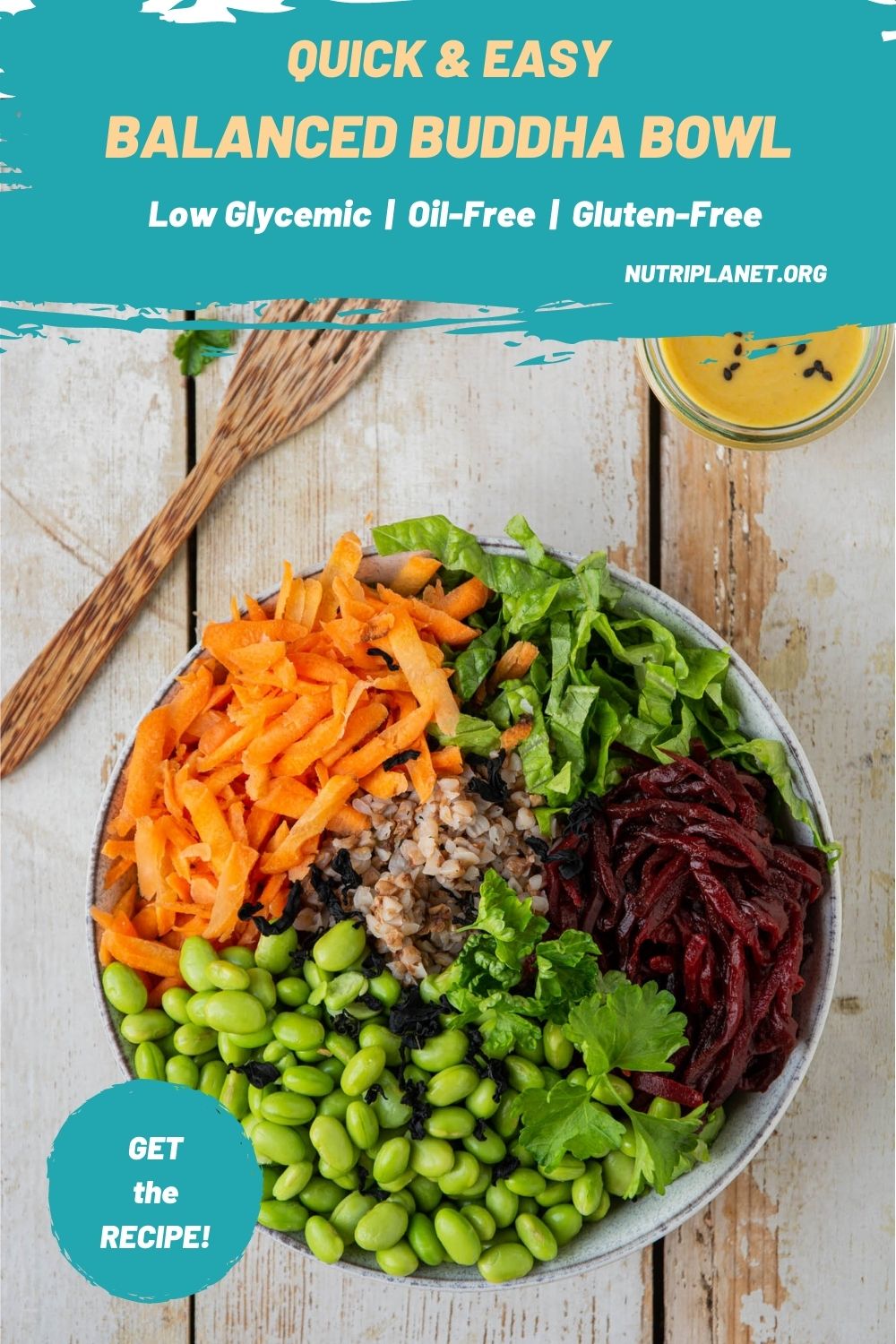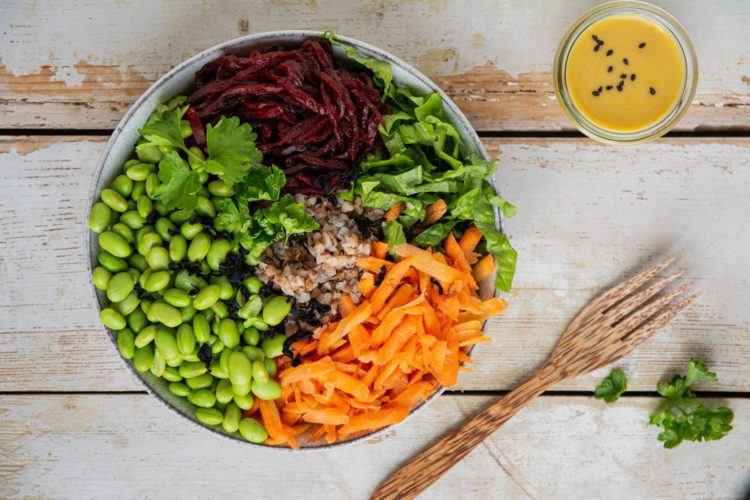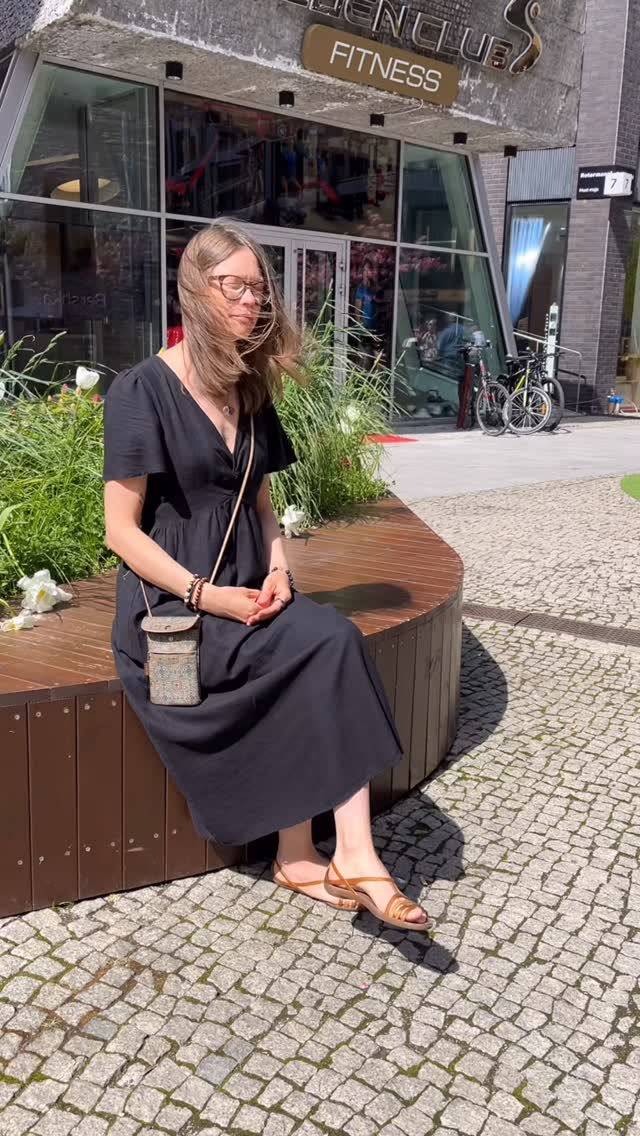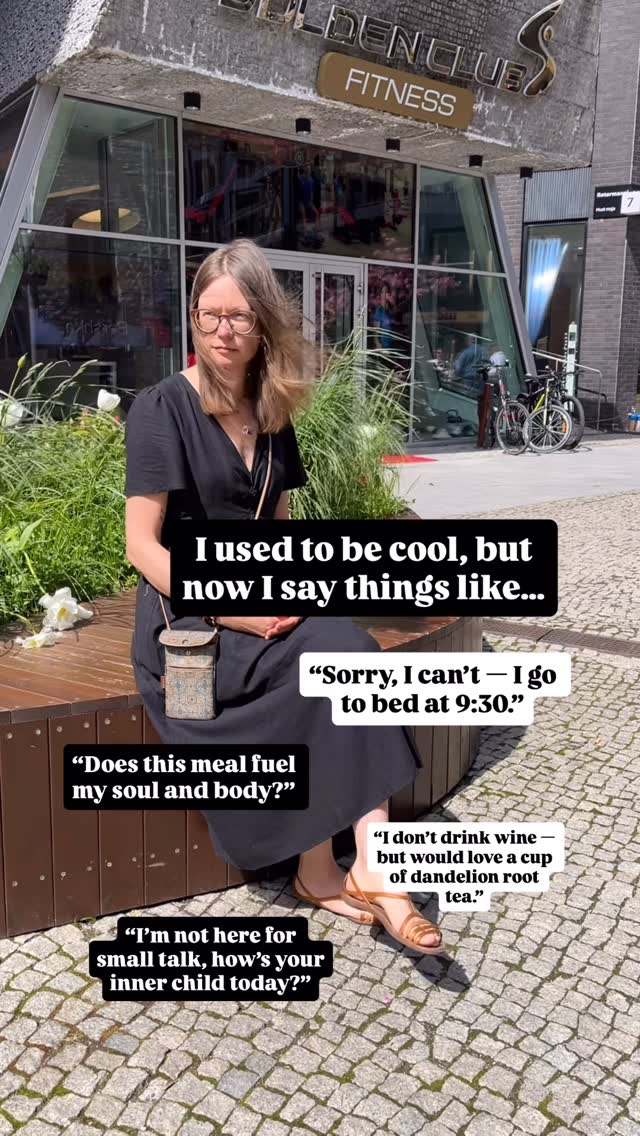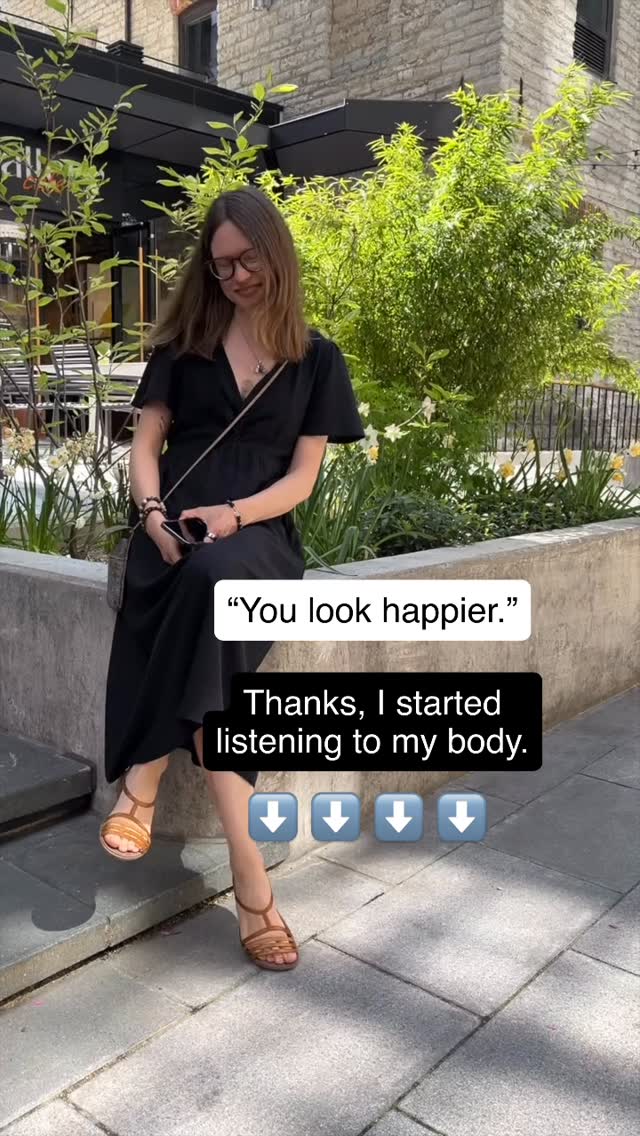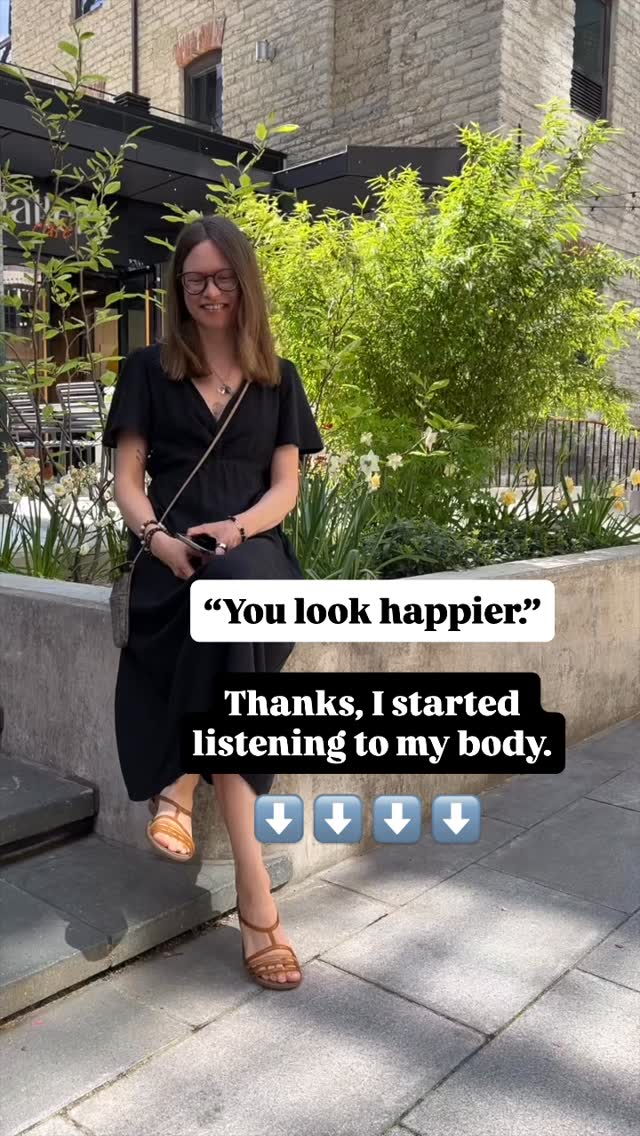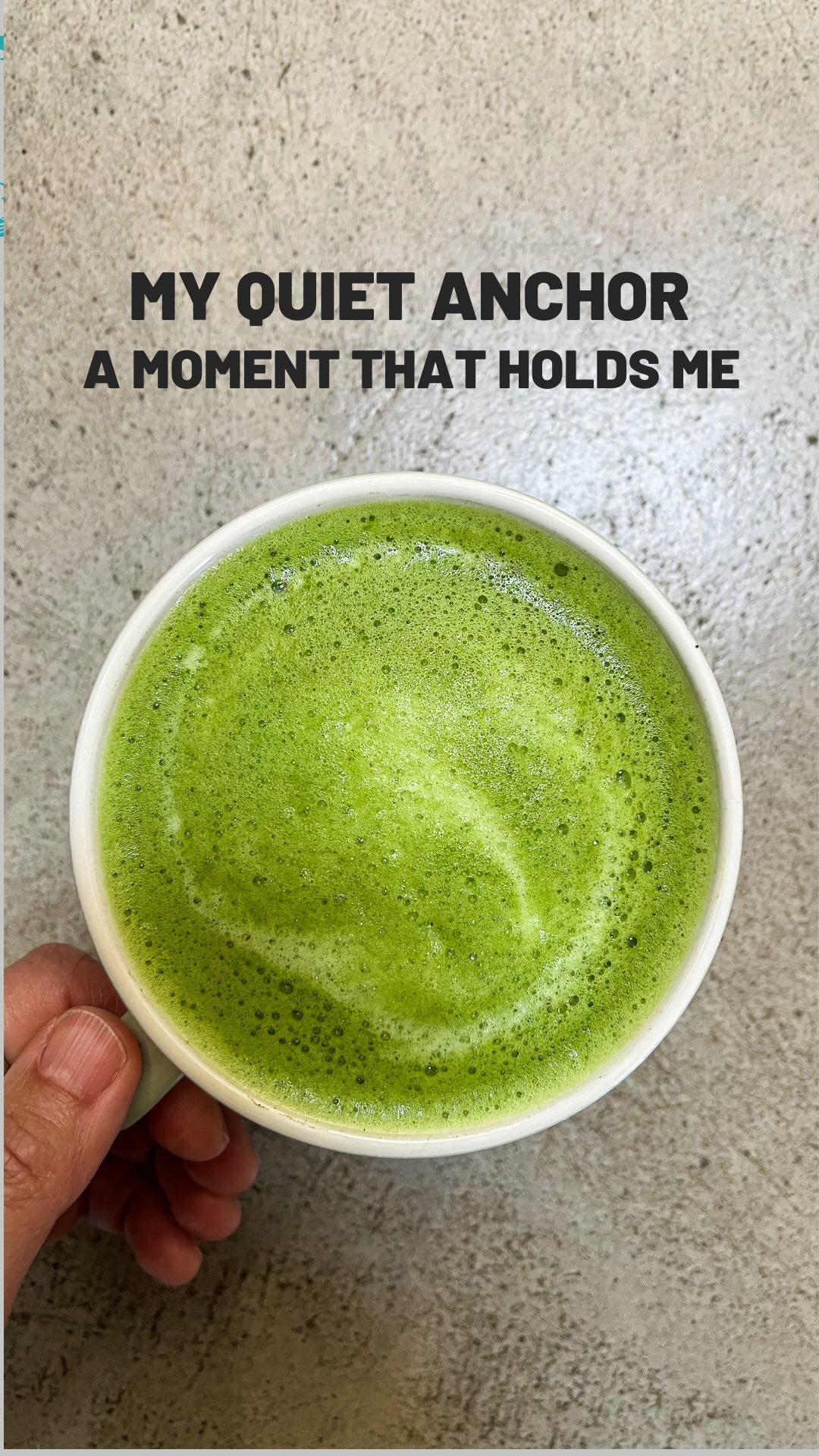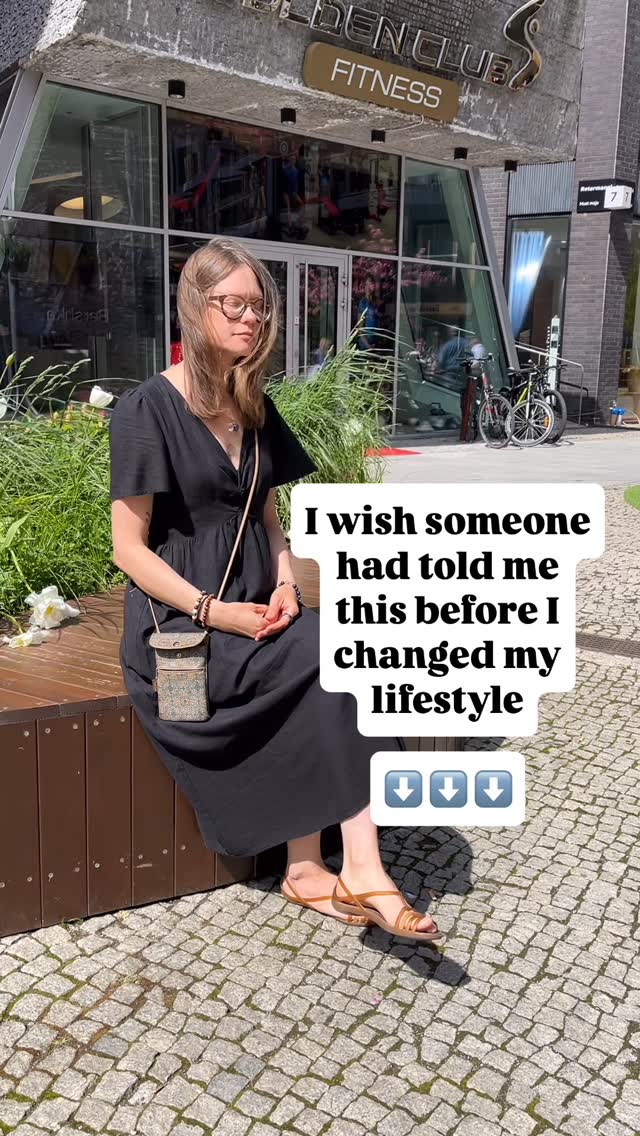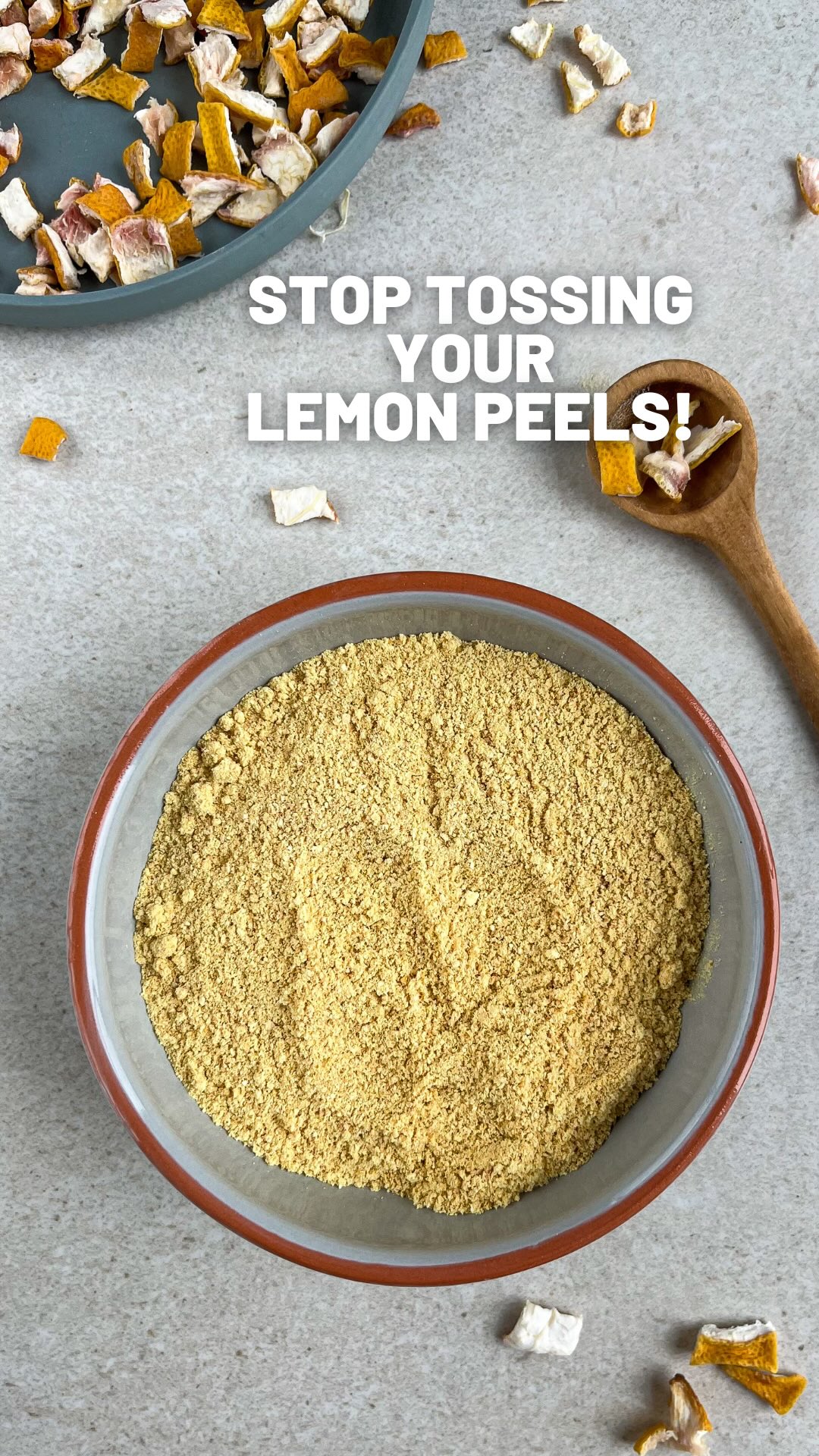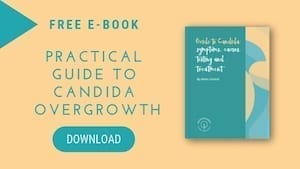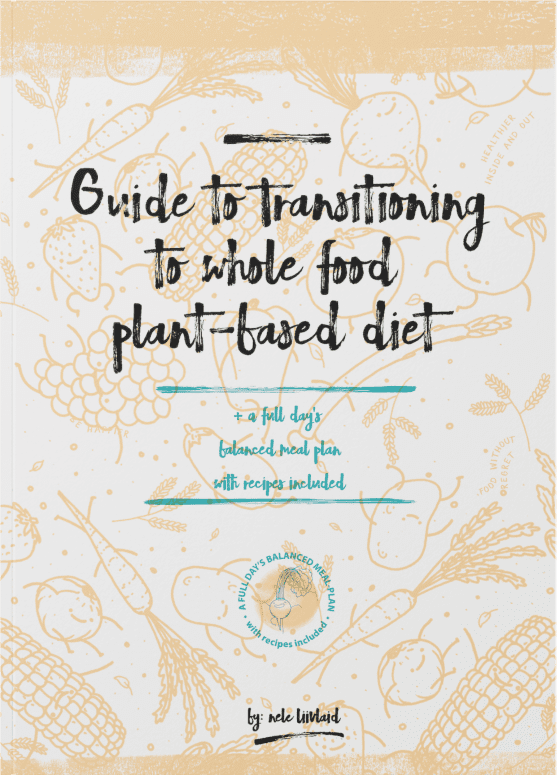Learn how to make a balanced and low glycemic vegan Buddha bowl for a quick and easy lunch or dinner. Whats more is that you’ll only need a few simple whole food plant-based ingredients and under 30 minutes to prepare this delicious bowl.
What I love about this recipe:
- Quick and easy to make.
- Super filling and satiating.
- Suitable for batch-cooking.
- Blood sugar balancing wholesome meal.
Besides being plant-based, this Buddha bowl is also gluten-free, suitable on a low glycemic diet as well as on a vegan Candida diet, peanut-free, and oil-free.
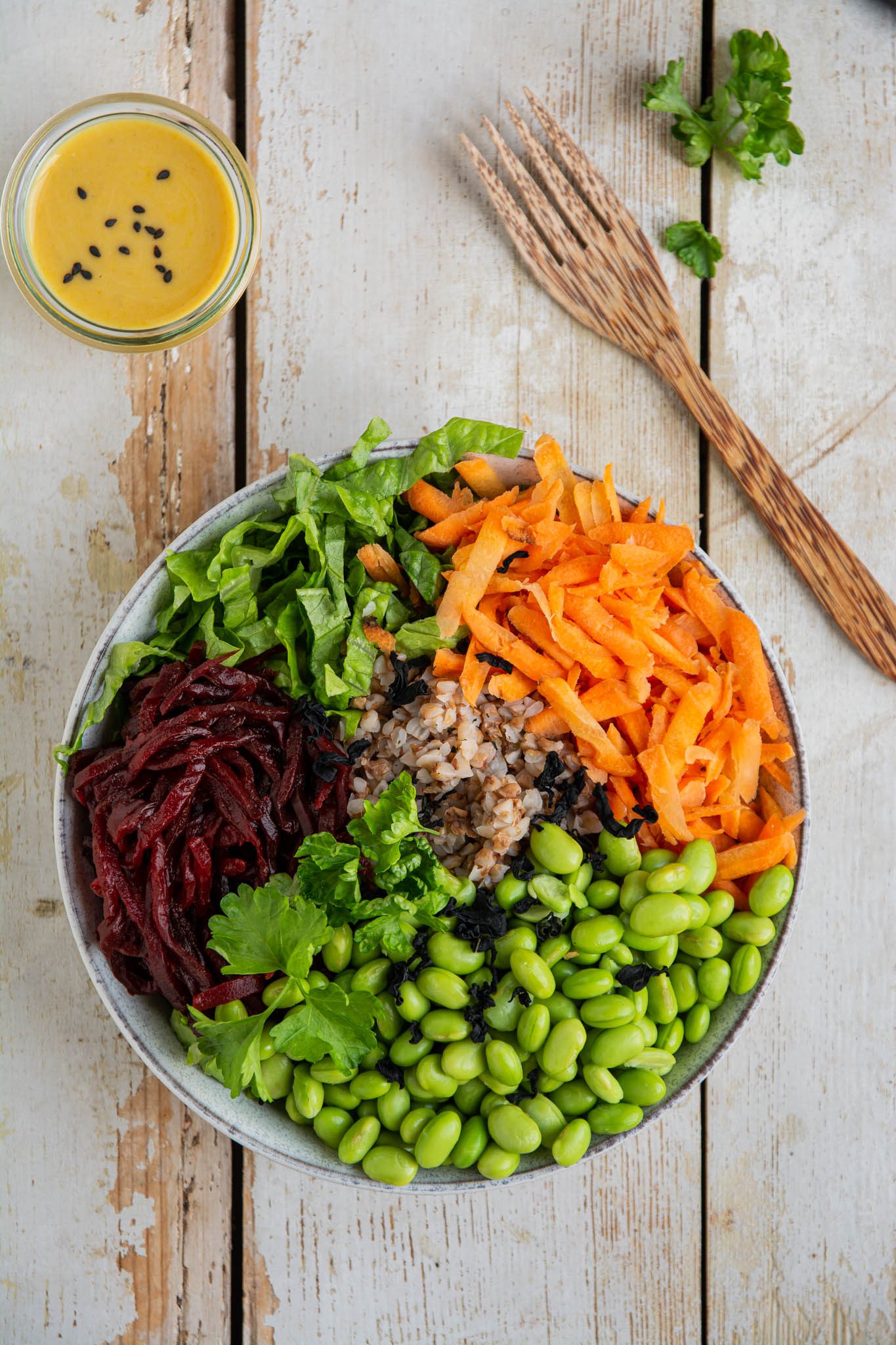
How to Make a Balanced Vegan Buddha Bowl
The Ingredients
It takes a few simple whole food plant-based components to compile a balanced vegan Buddha bowl.
For the Bowl
Let’s start with a green base, Romaine lettuce. I love lettuce because you don’t need to cook it but simply wash, chop and throw in a bowl.
Next come the fibrous grainy ingredient, cooked roasted buckwheat in this case. However, you may choose any grain or grain product you like e.g., quinoa, brown rice, millet, sorghum, oat groats, spelt or wheat berries. Alternatively, go for pasta made of whole grains.
The main protein source of this Buddha bowl is edamame beans. It’s so easy to cook the frozen beans and add to any meal. By the way, edamame beans make an excellent plant-based low glycemic ingredient. That being said, you can also eat them in larger quantities without adversely affecting your blood sugar. Other protein options include chickpeas, black beans, mung beans, peas, any types of lentils (red, brown, green, black), regular and fermented tofu, tempeh, or legume-based pastas.
In my opinion, you definitely need something crunchy in a Buddha bowl. So, this time I went for raw grated carrot. However, feel free to choose a different vegetable e.g., white or red cabbage, turnip, or bell peppers.
Another taste I need in my Buddha bowl is something sweet and starchy. In this recipe I’m using boiled grated beetroot. Alternatively, opt for steamed of oven-baked parsnip, sweet potato or pumpkin.
For the Dressing
Finally, you will need a delicious dressing to to make this Buddha bowl complete. You may choose any oil-free salad dressing but in this case I picked my miso-tahini dressing. To learn how to make tasty and wholesome dressings yourself, check out my comprehensive guide to oil-free salad dressings.
First, we’re going to use two types of miso – shiro miso and dark miso paste. Shiro miso comes with a sweet and cheesy flavour while dark miso is a bit stronger in taste. Did you know that the sodium content in miso is not harmful? It’s because the carcinogenic effects of the salt are counteracted by the anti-carcinogenic effects of the soy, effectively canceling out the risk. [Source]
Next comes tahini aka sesame seed paste. Alternatively, use any preferred nut or seed butter. For example, sunflower seed butter, peanut butter, almond butter etc.
Then, we add lemon juice for acidity and vitamin C. You may also choose apple cider vinegar or balsamic vinegar.
Garlic powder adds a divine flavour and turmeric gives a beautiful golden colour. Optionally, throw in some horseradish powder as well. I simply love its tanginess.
Finally, thin the dressing with water. Should you want to dilute it and/or end up with a larger quantity, add some plain plant yogurt.
The Process
First, let’s boil roasted buckwheat. By the way, I like to add a bay leaf for flavour and better digestibility. I prefer preparing a lot more than I need for my bowl, and store leftovers in the fridge for easy lunches for the next days.
Next, same goes for frozen edamame beans. I boil enough for a couple of days. Simply throw the beans into a pot, add water, bring to boil, and simmer for a few minutes. Then drain and let cool.
Now, while the buckwheat and edamame beans are cooking, we can prepare the rest of the ingredients. So, wash and chop Romaine lettuce, grate raw carrot as well as boiled beetroot. You’ll save a lot of time by using store-bought boiled and grated beetroot like I did.
Assembling the bowl is very easy – add shredded Romaine lettuce, ½ cup boiled buckwheat, ½ cup boiled grated beetroot (it may be cubed as well), ½ cup grated carrot, and 1 cup edamame beans.
In addition, you can sprinkle on some dried wakame seaweed for daily iodine as well. Alternatively, soak the wakame in water before adding it to the salad. For an extra boost, add some parsley or other herbs and/or microgreens.
As for the dressing, I have a thorough guide on how to make oil-free salad dressings. In this Buddha bowl, I’m using my miso-tahini dressing, which I’m making in this video. By the way, you can even download a free guide and print it out for easy access whenever needed!
You’ll learn how to make a dressing with oven-baked veggies and a delicious chickpea-tahini-yogurt dressing. Pick your favourite and prepare a bigger batch to store in the fridge for easy lunches and dinners.
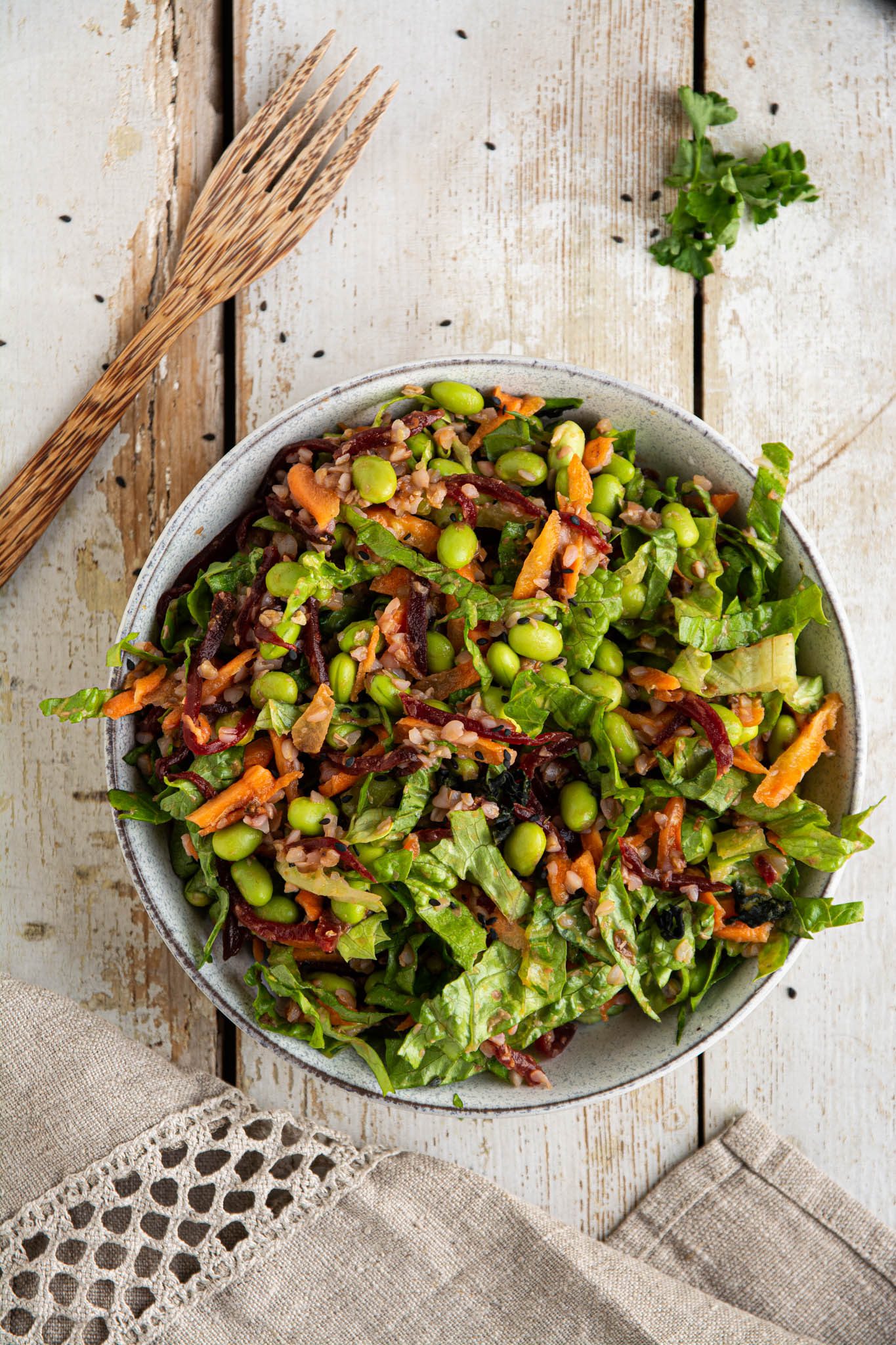
How to Serve
I prefer mixing everything up in a bigger bowl and eat it like that. So that all the flavours are evenly distributed. But it’s up to you!
Due to the tahini-based dressing, this bowl is a bit higher in fats. So, if you want to keep them down, choose a veggie or yogurt-based dressing.
Alternatively, make sure that the other meals of the day are leaner. By the way, this bowl contains plenty of protein and fibre.
Should you be a visual learner, watch how I make this nourishing and balanced low glycemic vegan Buddha bowl along with four other quick low glycemic lunch options, in the below video!
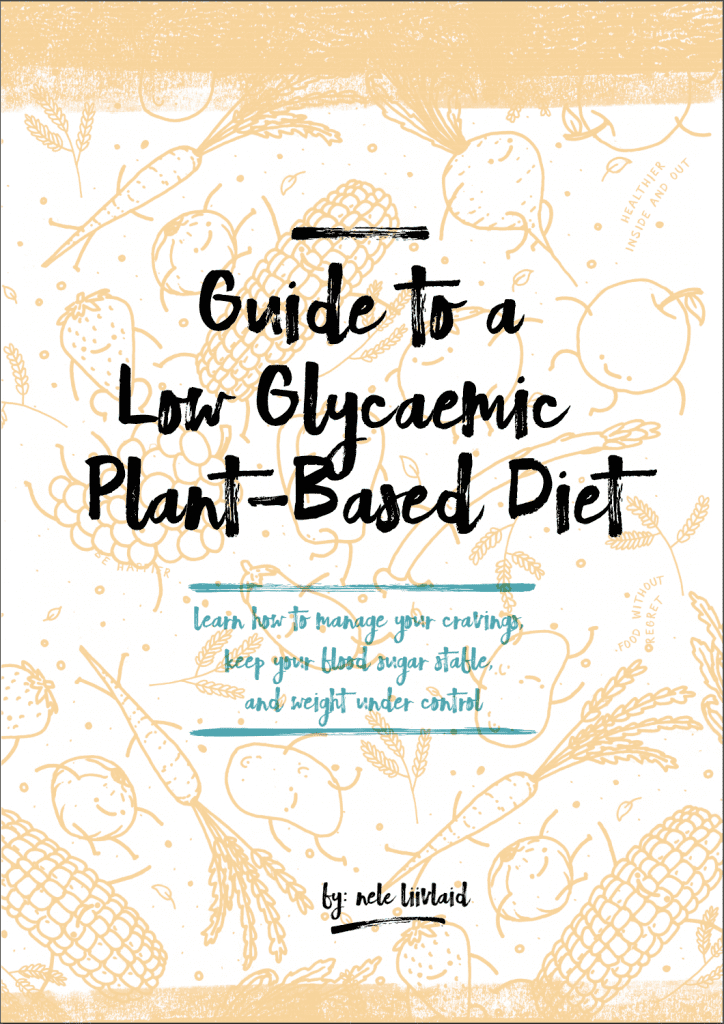
Download my Guide to Low Glycemic Plant-Based Diet!
What are glycemic index and glycemic load and why those matter.
The list of low, medium and high glycemic foods.
Easy tips on staying on a low glycemic diet.
Learn the secrets of stable blood sugar, weight loss, more energy, and better health
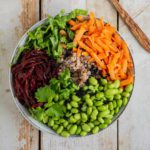
Balanced Vegan Buddha Bowl for Lunch or Dinner [Video]
- Total Time: 30 minutes
- Yield: 1 serving 1x
- Diet: Vegan
Description
Learn how to make a balanced and low glycemic vegan Buddha bowl for a quick and easy lunch or dinner. Whats more is that you’ll only need a few simple whole food plant-based ingredients and under 30 minutes to prepare this delicious bowl.
Ingredients
For the bowl:
- ½ cup (80g, 2.8oz) cooked roasted buckwheat
- ½ cup (60g, 2.1oz) boiled beetroot, grated or cubed
- 1 cup (150g, 5.3oz) boiled edamame beans
- 80g (2.8oz) Romaine lettuce
- 1 medium carrot (60g, 2.1oz)
For the dressing (blend):
- 1 tsp. shiro miso
- 1 tsp. dark miso
- 2 tsps. tahini
- 2 tsps. lemon juice or apple cider vinegar
- ¼ tsp. turmeric
- ¼ tsp. garlic powder
- 1/8 tsp. horseradish powder (optional)
- 1 tbsp. + 1 tsp. water (adjust according to preferences)
Instructions
- First, boil roasted buckwheat. I boil 100 grams (3.5oz) of dry buckwheat with 390 grams (13.8oz) of water for 15 minutes. By the way, I like to add a bay leaf for flavour and better digestibility. Store leftovers in a sealed container in the fridge for the next days.
- At the same time, boil frozen edamame beans. Again, I boil enough for a couple of days. Simply throw the beans into a pot, add water, bring to boil, and simmer for a few minutes. Then drain and let cool.
- Now, while the buckwheat and edamame beans are cooking, prepare the rest of the ingredients. So, wash and chop Romaine lettuce, grate raw carrot and boiled beetroot. You’ll save a lot of time by using store-bought boiled and grated beetroot.
- Next, add to a bowl: shredded Romaine lettuce, ½ cup boiled buckwheat, ½ cup boiled grated beetroot (it may be cubed as well), ½ cup grated carrot, and 1 cup edamame beans.
-
In addition, you can sprinkle on some dried wakame seaweed for daily iodine. Alternatively, soak the wakame in water before adding it to the salad. For an extra boost, add some parsley or other herbs and/or microgreens.
Notes
Feel free to use brown rice, quinoa, sorghum, oat groats, teff, or millet instead of buckwheat. Or, if gluten is not an issue for you, also kamut, whole wheat berries or spelt berries will be excellent in this Buddha bowl.
For more dressing ideas, check out my Guide to Oil-Free Salad Dressings.
- Prep Time: 15 minutes
- Cook Time: 15 minutes
- Method: Stovetop
Nutrition
- Serving Size: The whole recipe
- Calories: 417 kcal
- Sodium: 750.3mg
- Fat: 15.1g
- Saturated Fat: 2g
- Carbohydrates: 33.2g
- Fiber: 17g
- Protein: 27.6g
Disclosure: this post contains affiliate links. As an Amazon Associate I earn from qualifying purchases. For every purchase made from the links in this post, you’ll be able to support my work. So you can look after your health, and contribute to my mission at the same time. Thank you!
You’re welcome to PIN the below image!
